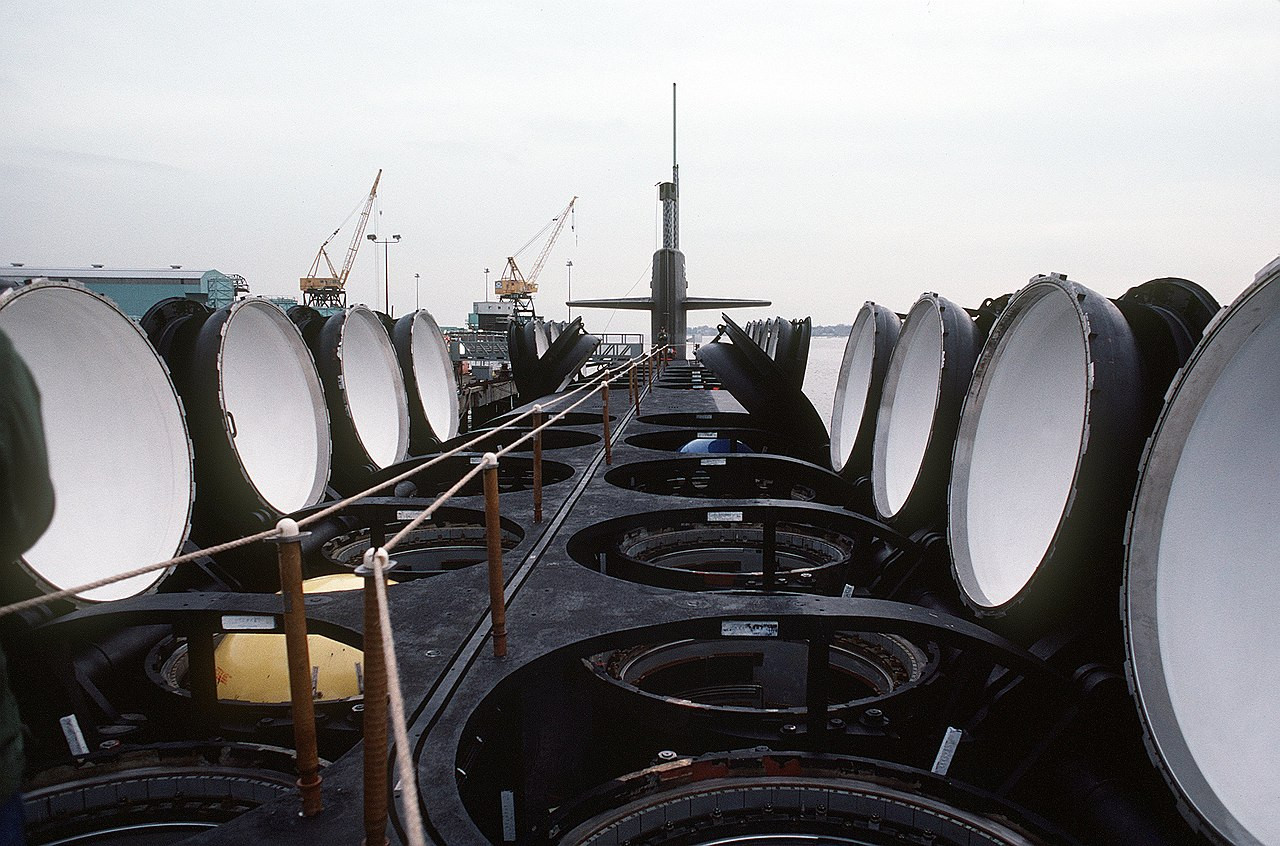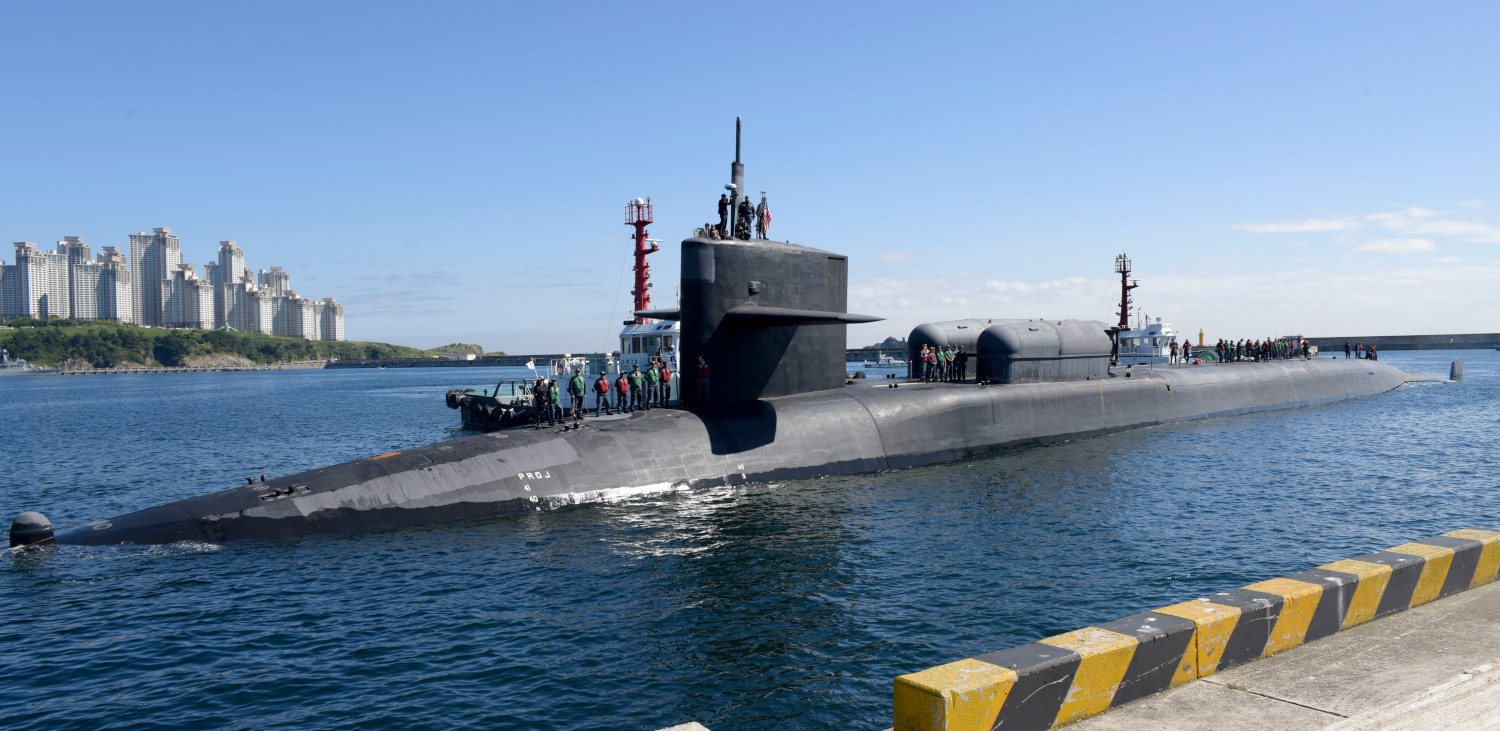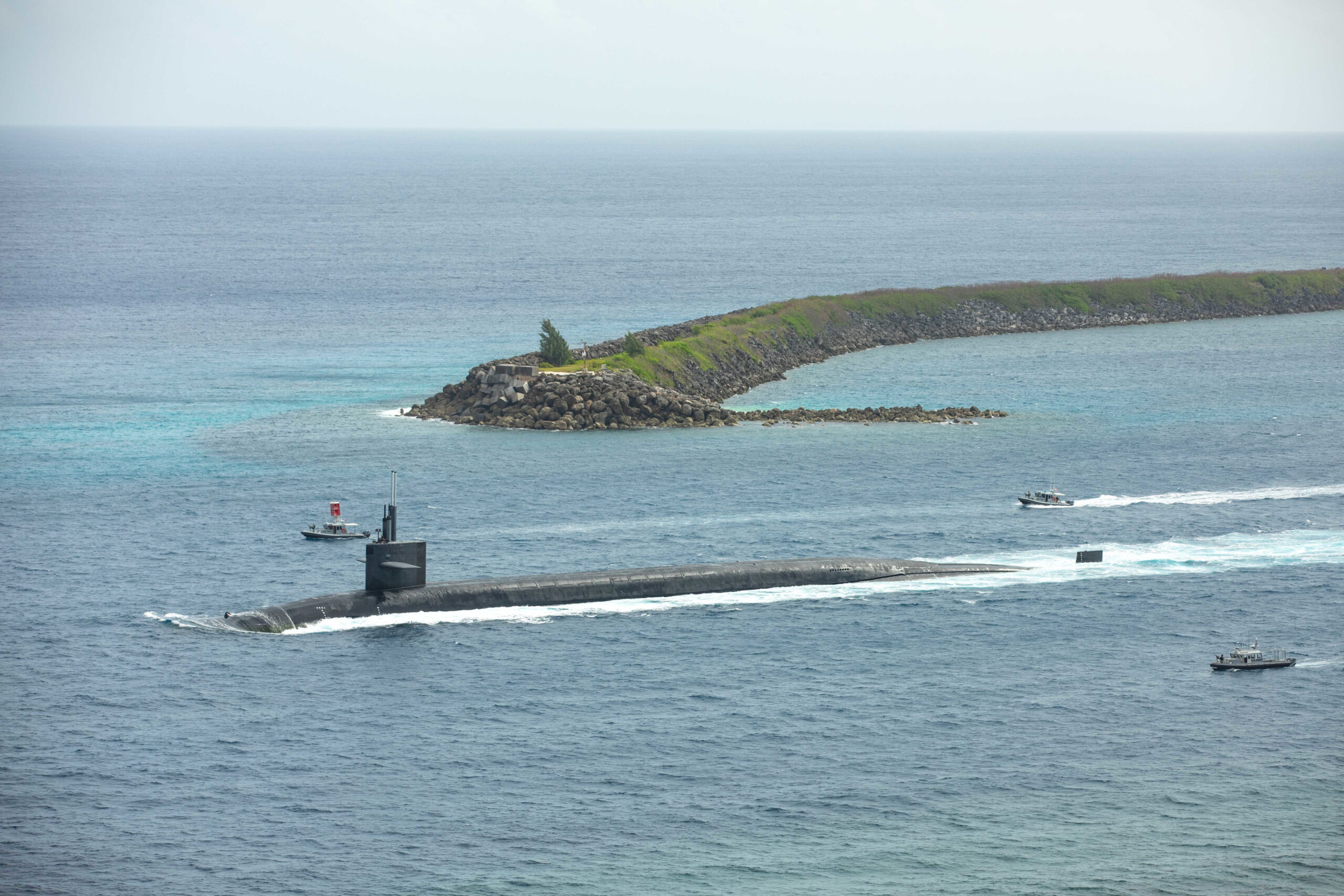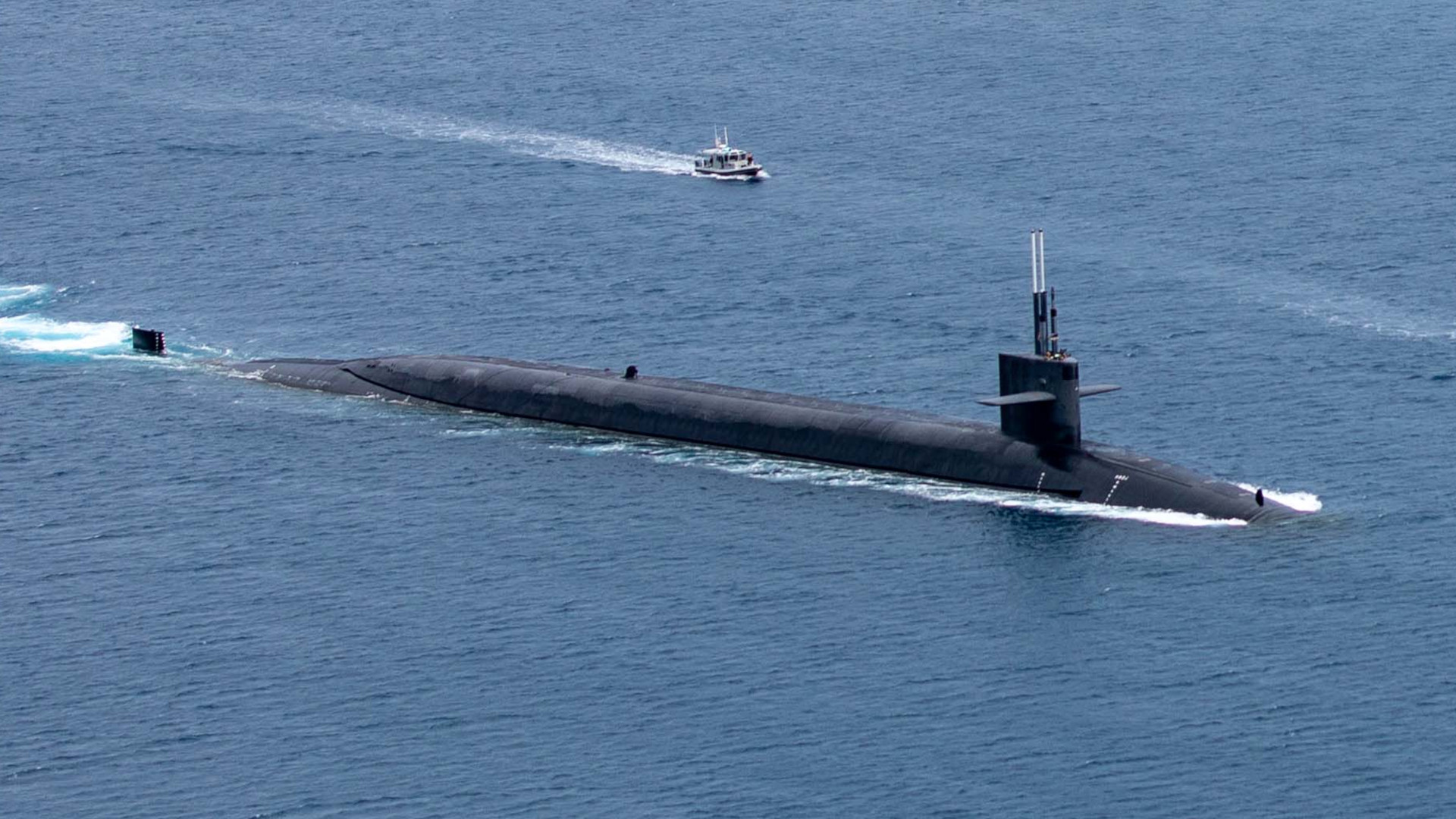A U.S. Navy Ohio class nuclear ballistic missile submarine is reportedly set to make a visit to South Korea sometime in the near future. This will be the first time one of these submarines has made a port stop on the Korean Peninsula in at least four decades. This is part of broader plans to more visibly demonstrate America’s ability and willingness to use its nuclear capabilities to defend South Korea if need be in the face of growing concerns about threats from North Korea.
Multiple outlets reported on the expected submarine visit earlier today, citing unnamed U.S. government officials. This could be the first of many such visits by Ohio class ballistic missile submarines, or SSBNs. Each of the Navy’s 14 Ohio SSBNs can carry up to 20 Trident II submarine-launched ballistic missiles. The Trident II has a so-called multiple independently targetable reentry vehicle (MIRV) configuration and each one can carry up to 14 individual warheads. The Trident IIs are typically loaded with either W76-1 or W88 series warheads, which have estimated maximum yields of 100 kilotons and 475 kilotons, respectively.

However, it is largely understood that Ohio SSBNs conduct patrols with missiles that have fewer than 14 warheads apiece, as a byproduct of various arms control deals with Russia. In addition, Ohio SSBNs are now sailing with at least some of their Trident IIs fitted with at best a very small number – maybe even just one per missile – of low-yield W76-2 warheads.
The U.S. military is also now looking to step up shows of force involving bombers capable of carrying nuclear weapons, which could include temporary deployments to the Peninsula, according to those same reports. An uptick in U.S. Navy aircraft carrier operations in the region might be another component of this new reassurance effort.
In addition, the Washington Declaration will reportedly include a new U.S.-South Korean “nuclear consultative group.” This entity “will focus on ‘nuclear and strategic planning issues’ and give the South Korean side ‘new insights’ into how the U.S. plans for scenarios like a possible nuclear exchange,” Axios reported, citing an anonymous U.S. government official.
None of this is expected to involve the permanent redeployment of U.S. nuclear weapons in South Korea. American forces maintained a nuclear stockpile on the Peninsula for much of the Cold War, but the U.S. government decided to remove them in 1991.
It is worth remembering that one of the U.S. Navy’s four Ohio class guided missile submarines, or SSGNs, USS Michigan, did make a stop in Busan, South Korea, in 2017, amid a spike in tensions with the North. The Ohio SSGNs are not capable of employing nuclear weapons, with their launch tubes being repurposed to primarily fire Tomahawk cruise missiles. Those tubes can also be used to deploy other payloads, including uncrewed platforms. The four converted Ohios, overall, are extremely capable multi-purpose platforms that can carry out stand-off conventional strikes, act as motherships for special operations forces, serve as underwater intelligence fusion centers and command posts, and more, as you can read about in this past War Zone feature.

The U.S. Navy has also been increasingly more inclined in recent years to publicly disclose visits by Ohio SSBNs, as well as Ohio SSGNs, to various locales around the world. These announcements are widely viewed as tools to reassure allies and partners and signal resolve to adversaries or potential adversaries. As an example of this trend, today’s news follows the Navy’s official release yesterday of pictures showing the Ohio SSBN USS Maine making a stopover at the service’s base on the strategic Western Pacific island of Guam on April 18.

Shows of force around the Peninsula involving U.S. bombers, as well as other American and South Korean combat aircraft, have become routine in response to North Korean missile tests and other provocations, too. This all being said, the bombers in question have often been conventional-only B-1s, rather than nuclear-capable types. It’s also important to remember that these kinds of flights also occurred regularly for years prior to a period of detente between the United States and North Korea during President Donald Trump’s term in office.
The reported planned Ohio SSBN visit and other rotational deployments are part of a broader set of new agreements between the United States and South Korea, which will reportedly be collectively referred to as the Washington Declaration. This is set to be formally announced later today as part of South Korean President Yoon Suk Yeol’s state visit to Washington, D.C.
This also follows months now of Yoon and his government very openly lobbying for significantly increased South Korean participation in matters of deterrence on the Peninsula, particularly with regard to the possibility of retaliating against a North Korea nuclear strike.
In January, Yoon caused a stir by calling for more direct South Korean involvement in nuclear planning exercises with its American counterparts, something U.S. officials rebuffed at the time. The U.S. government’s response at the time seemed to be that it would continue to have active discussions about potential nuclear response options with its South Korean counterparts, but that it had no plans for any deeper coordination on their actual use. The expected establishment of a new U.S.-South Korean nuclear consultative group would seem to reflect continued discussions on this matter.
It is worth noting that, under current U.S.-South Korean agreements, should a full-scale war break out on the Peninsula again, the U.S. military would exercise operational control (OPCON) of all American and South Korean military units. Negotiations to transfer wartime OPCON of South Korean forces to the country’s independent military command structure have been underway for years now.

Later in January, Yoon had gone one step further, implying that, depending on how the security situation on the Peninsula might evolve, his country could be compelled to develop its own nuclear weapons. This would, of course, be a massive shift in policy for South Korea, which is currently a signatory to the Nuclear Non-Proliferation Treaty (NPT). In light of this, the Washington Declaration is expected to also include a reaffirmation by the South Koreans of their obligations under the NPT, including not pursuing a nuclear weapons program.
A key element of the backdrop to all of this is North Korea’s steady demonstration in recent years of an ever-expanding arsenal of strategic and tactical weapon systems likely capable of delivering nuclear warheads, together with a growing stockpile of those weapons and the material needed to make more. Just in the past few years, North Korean forces have tested an array of differently sized ballistic missiles, including ones capable of being fired from submarines, railcars, and more protected static positions on land and underwater, as well as various mobile ground-based launchers. North Korea claims that one of these newer ballistic missiles is tipped with a hypersonic boost-glide vehicle, as well. On top of all that, just this month, the regime in Pyongyang conducted a test of the country’s first solid-fuel intercontinental ballistic missile (ICBM), an important leap in technology and capability.
Added to this are a slew of other munitions that North Korea says are nuclear-capable, or those that the country might be looking to fit with nuclear warheads onto. This includes ground-launched long-range cruise missiles, very large artillery rockets, and even a purported uncrewed underwater vehicle.
North Korean developments have already prompted something of a missile race on the Peninsula, with South Korea having demonstrated a number of its own new ballistic and cruise missiles in recent years. The South Korean weapons are all, at least for now, conventionally armed.
There has been more conventional friction between North and South Korea recently, too, sparked in part by the return to more regular public large-scale U.S.-South Korean military exercises. This includes multiple instances last year of North Korean artillery units firing shells into maritime buffer zones. The government in Pyongyang has a long history of provocative reactions to U.S. and South Korean forces training together, routinely asserting without evidence that these activities are simply rehearsals for a full-scale invasion of the North.

Altogether, today’s expected Washington Declaration would seem to be as much about trying to slow the overall arms race that is developing – and trying especially to put a stop to any talk about South Korean nuclear weapons – as it is about signaling American resolve to North Korea in support of its ally on the Peninsula.
The exact terms of the new arrangements do of course remain to be seen. If the reports so far are accurate, South Korea looks set to at least see the first visit by an Ohio class SSBN since the 1980s.
UPDATE 3:35 P.M. EST:
U.S. President Joe Biden and his South Korean counterpart Yoon Suk Yeol have now held a joint press conference where they, in part, provided additional details about the Washington Declaration and their new extended deterrence plans. Neither leader specifically confirmed plans for a visit by an Ohio class SSBN to South Korea, though Biden did mention future “port visits” involving unspecified “nuclear submarines.”
“Sustainable peace on the Korean Peninsula does not happen automatically,” Yoon said, speaking through a translator. “[We] have decided to significantly strengthen [the] extended deterrence of our two countries. against North Korea’s nuclear and missile threats so that we can achieve peace through the superiority of overwhelming forces and not a false peace based on the goodwill of the other side.”
“Our two countries have agreed to immediate bilateral ]residential consultations in the event of North Korea’s nuclear attack and promise to respond swiftly, overwhelmingly, and decisively using the full force of the Alliance including the United States’ nuclear weapons,” he continued. “Our two countries have agreed to establish a nuclear consultative group to map out a specific plan to operate the new extended deterrence system.”
“Now, our two countries will share information on nuclear and strategic weapon operations plans in response to North Korea’s provocations, and have regular consultations on ways to plan and execute joint operations that combine [South] Korea’s state-of-the-art conventional forces with the U.S.’s nuclear capabilities,” he added. “The results [of the NCG’s work]… will be reported to the leaders of our two countries on a regular basis.”
Yoon also said that the United States and South Korea would also engage in advanced tabletop exercises concerning potential nuclear crises on the Peninsula and confirmed plans for more regular temporary deployments of unspecified “strategic assets.”
“I can’t talk to the specifics right now about what type of information [we will be sharing] and what type of specific activities we will be conducting, but… under the nuclear umbrella, our extended deterrence was a lot lower [previously],” Yoon further explained. “So, right now it’s an unprecedented expansion and strengthening of the extended deterrence strategy under the Washington Declaration.”
“A nuclear attack by North Korea against the United States or its allies and… partners is unacceptable and will result in the end of whatever regime were to take such an action,” President Biden added. The new extended deterrence plans are “about strengthening deterrence in response to the DPRK’s escalatory behavior.”
“I have absolute authority as commander-in-chief and the sole authority to use the [U.S.] nuclear weapon, but you know, what the declaration means is that we’re going to make every effort to consult with our allies, when it’s appropriate,” Biden continued. “The bottom line here is there’s even closer cooperation, closer consultation, and we’re not going to be stationing nuclear weapons on the Peninsula.”
The official White House video of the press conference is seen below.

Contact the author: joe@thedrive.com
